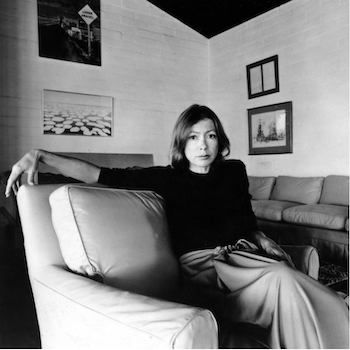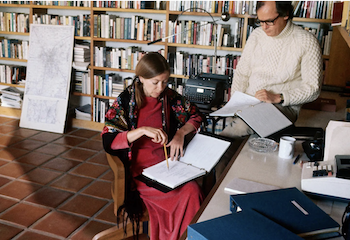
On December 5, 1934, Joan Didion was born in Sacramento, California on a military base. Her parents were Eduene and Frank Reese Didion, and she had a younger brother named James. Frank was a finance officer in the Army Air Corps, which caused Didion’s family to move frequently during World War II. One of Didion's first memories of writing included her childhood typewriter. Specifically, with the device, she taught herself how to type by writing Ernest Hemingway sentences repeatedly. While attending McClatchy High School in Sacramento, Didion was a member of the school newspaper staff. After secondary school, Didion attended the University of California, Berkeley, graduating in 1956 with a bachelor's degree in English.
After Didion graduated college, she began to work with Vogue magazine in New York as a copywriter, and she was later promoted to an associate features editor position. “On Self-Respect: Its Source, Its Power'' was Didion's most famous Vogue-published essay, debuting in 1961. This essay explores the subject of self-respect and acceptance. Furthermore, it emphasizes the acceptance of consequences, and it was inspired by Didion’s own experience with failure throughout her young adulthood and early career. This essay would make an appearance again in “Slouching Towards Bethlehem'', Didion’s first non-fiction work which illustrated life in America in the 1960s. In 1963, the same year Didion decided to part ways with Vogue, she published her first fiction thriller novel titled “Run River” which explores themes such as marriage and betrayal.
While in New York, Didion met her husband John Gregory Dunne. In 1964, Didion then decided to return to her home state of California with Dunne after getting married. Didion would often collaborate with Dunne on artistic projects, but mostly screenplays. At the age of 31, Didion adopted her first and only child: Quintana Roo Dunne. Both Dunne and Quintana would be inspirations for Didion's works in the future.

Didion published a slew of impactful projects throughout this prime period of her career. For instance, Didion published the nonfiction essay “White Album” in 1979, further developing her philosophies in the 1960s era and the aftermath of the decade. In this work, Didion further explored the “paranoia and absurdity” of American society and challenged many aspects of pop culture during the era. She did this by referencing many iconic events and places, such as the Manson murders and shopping malls, while providing commentary on civil issues and her own experience.
Specifically, some of her most notable works were “Where I Was From” (2003) and “Blue Nights” (2011). “Where I Was From” serves as a reflection on Didion’s life as a native Californian. In addition, “Blue Nights” is written about Didion’s thoughts on motherhood and growing older. These pieces cemented Didion's career as an esteemed writer because of their raw vulnerability and relatability. Dunne died from a heart attack in 2003, and shortly after, Quintana died at 39 due to pancreatitis.
Didion’s projects have won many awards for their evocative nature. Arguably Didion’s most famous book, “The Year of Magical Thinking,” won the National Book Award for Nonfiction in 2005, and was a Pulitzer Prize finalist. This book was written in reflection of her daughter's illness and the death of her husband. In addition, this piece of writing explores the theme of mourning, and the process of writing helped Didion process her losses.

Also in 2005, she won the American Academy of Arts And Letters Gold Medal in Belles Lettres and Criticisms. In 2007, she was awarded the National Book Foundations Medal for Distinguished Contribution to American Letters. This award recognized Didion’s impact on American literary culture. Additionally, the National Humanities Medal was given by President Barack Obama in 2013, along with the PEN Center USA’s Lifetime Achievement Award.
Didion died from Parkinson's disease on December 23, 2021. She was 87 years old. Her last work was a memoir titled “Let Me Tell You What I Mean” (2021).
Throughout her career, Didion merged a variety of writing-based professions. She was a journalist, essayist, screenwriter, and novelist. She was able to grasp a wide variety of writing mediums throughout her life to produce philosophical and thought-provoking works about the period in which she lived. Didion is often referred to as a pioneer in "New Journalism”, an American literary movement that took place in the 1960s and 70s. This movement challenged journalistic traditions and led to the alteration of how events are reported by utilizing a combination of research and historically fictional techniques. The writing style of “New Journalism” mimics a fictional story by introducing characters, dialogue, and graphic scenes. Didion brought her stories to life using this technique, and the moving nature of her narratives has inspired writers for many years.
Why Did I Choose to Research Joan Didion?
I chose Joan Didion because of her undeniable aptitude for inspiring and thought-provoking writing. Throughout my entire life, I have been a writer. I have memories of creating stories with my grandmother in my little lined notebook as a young child. After getting a typewriter for Solstice one year, I continued to write short stories on it for many years. Currently, I write for my high school newspaper, and now iFeminist! Writing as a creative medium has been a steady outlet for me to count on from my earliest memories. How Didion wields her talent for writing inspires me to use my passion for the art to make a meaningful product. While writing can be used to create a form of entertainment, it can also be used to document history and be a form of significant non-self-serving expression. I can see myself in the concepts of “New Journalism” in how I write for my school newspaper, and how I wish to continue to write in my journalistic career. Didion is also a woman who overcame many obstacles and hardships throughout her life, and I find her perseverance to be admirable.
Works Cited
Fakazis, Liz. “New Journalism | American Literary Movement.” Encyclopædia Britannica, 28 Mar. 2016, http://www.britannica.com/topic/New-Journalism Accessed 30 Mar. 2024.
“Joan Didion | Biography, Books, & Facts.” Encyclopedia Britannica, Encyclopedia Britannica, http://www.britannica.com/biography/Joan-Didion Accessed 30 Mar. 2024.
“JOAN DIDION | the Official Website.” Joandidion.org, www.joandidion.org/. “JOAN DIDION’S CHILDHOOD.” Joandidion.org, http://www.joandidion.org/a-childhood-in-sacramento Accessed 31 Mar. 2024.
Los Angeles Times. “Joan Didion, Masterful Essayist, Novelist and Screenwriter, Dies at 87.” YouTube, 23 Dec. 2021, http://www.youtube.com/watch?v=PPo4FtjQaWM Accessed 31 Mar. 2024.
Manufacturing Intellect. “Joan Didion Interview (1992).” YouTube, 1 May 2016, http://www.youtube.com/watch?v=v13u9sJA5ks Accessed 31 Mar. 2024.
Mead, Rebecca. “The Most Revealing Moment in the New Joan Didion Documentary.” The New Yorker, 27 Oct. 2017, http://www.newyorker.com/culture/cultural-comment/the-most-revealing-moment-in-the-new-joan-didion-documentary#:~:text=Having%20endured%20the%20death%20of Accessed 31 Mar. 2024.
Nast, Condé. “On Self-Respect: Joan Didion’s 1961 Essay from the Pages of Vogue.” Vogue, 22 Oct. 2014, http://www.vogue.com/article/joan-didion-self-respect-essay-1961#:~:text=Here%2C%20in%20its%20original%20layout Accessed 31 Mar. 2024.
“Run River.” Goodreads, http://www.goodreads.com/en/book/show/7831 Accessed 31 Mar. 2024.
“Slouching towards Bethlehem.” Goodreads, http://www.goodreads.com/en/book/show/424 Accessed 31 Mar. 2024.
Stamberg, Susan. “In Sorrowful “Blue Nights,” Didion Mourns Her Daughter.” NPR.org, 1 Nov. 2011, http://www.npr.org/2011/11/01/141862057/sorrowful-blue-nights-didion-mourns-her-daughter Accessed 31 Mar. 2024.
The Awards Contender. “Joan Didion | an Underappreciated Screenwriter.” Www.youtube.com, 26 Dec. 2021, http://www.youtube.com/watch?v=9gsWG7wvmmk Accessed 31 Mar. 2024.
This article was published on 6/4/24